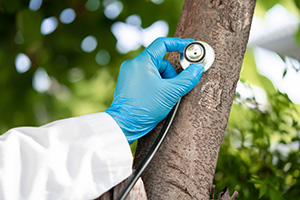Maintaining the health and beauty of the trees in Smithville requires vigilance and expertise, especially when it comes to identifying and managing pests and diseases. Trees are an integral part of our landscape. They provide shade, enhance property values, and contribute to the local ecosystem. However, they are vulnerable to various threats that can compromise their health and vitality. Whether it’s the telltale signs of insect infestations, such as discolored leaves or boreholes, or the more subtle symptoms of fungal infections like unusual growths or wilting branches, early detection is crucial. Experienced Smithville tree service companies like Ben Bivins Tree Experts are dedicated to helping homeowners and property managers recognize these issues before they escalate. This guide will walk you through the most common tree pests and diseases in the Smithville area and provide actionable steps to address them, ensuring your trees remain robust and resilient for years to come.
Common Tree Pests in Southern New Jersey and What They Do to Trees and How to Manage Them
Emerald Ash Borer
The Emerald Ash Borer (EAB) is a small, metallic green beetle. Infestation signs include D-shaped exit holes, bark splitting, and increased woodpecker activity. EAB larvae feed on the inner bark, disrupting the tree’s ability to transport water and nutrients, leading to dieback and eventual death. One preventative measure homeowners can take are systemic insecticides. They can protect healthy ash trees. Infected trees can be treated with insecticides, but heavily infested trees may need to be treated or removed by a professional.
Southern Pine Beetle
This beetle is small, about the size of a grain of rice, and reddish-brown. Look for pitch tubes on the bark and winding S-shaped galleries under the bark. Southern Pine Beetles attack pine trees specifically. They cause yellowing needles, canopy thinning, and eventual tree death. It is important for homeowners to regularly inspect pine trees for signs of infestation. One way to manage these beetles is to remove and destroy infested trees to prevent spread. Another is to prevent them with insecticides. Effective management can be achieved with the help of Smithville tree service experts.
Gypsy Moth
Gypsy moth caterpillars have distinctive blue and red spots and can be found feeding on leaves during spring and early summer. These caterpillars will often be found on trees including oak, apply, birch, poplar, and willow. Defoliation caused by caterpillars can weaken trees, making them susceptible to other stresses and diseases. One strategy to manage gypsy moths is to remove egg masses manually and use burlap bands to trap caterpillars. Some homeowners may need to take more drastic measures and use biological control such as the introduction of natural predators like birds or parasitic wasps. As far as insecticides, they must be used during larval stages to be effective. Expert assistance is necessary for large infestations.
Tree Diseases Smithville Tree Experts See Often and How They Manage Them
Oak Wilt
Symptoms include leaf discoloration, wilting, and premature leaf drop. Homeowners should look for fungal mats under the bark with a distinct sweet odor. Oak Wilt harms trees by disrupting water flow in the tree. This leads to rapid wilting and death, especially in red oaks. Fungicide injections can protect healthy trees and professionals will usually avoid pruning oaks during the growing season. In order to contain this disease, it is best to remove and destroy infected trees to prevent spread.
Dutch Elm Disease
To identify Dutch Elm Disease, look for yellowing and wilting leaves, often starting from the top of the tree. Brown streaking in the sapwood is another key diagnostic feature. Similar to Oak Wilt, this disease blocks water movement, causing branch dieback and death within one to several years. Homeowners should remove infected branches and trees promptly as fungicide injections are only effective if applied early. The only way to truly prevent this disease is to plant disease-resistant elm varieties.
Anthracnose
Inspect sycamores, maples, and oaks and look for dark, sunken lesions on leaves, stems, flowers, and fruits. The damage caused by this malady is defoliation and twig dieback, weakening the tree over time. To help prevent Anthracnose, when planting, ensure proper spacing for air circulation and remove fallen leaves to reduce spore spread. Furthermore, fungicide applications in early spring can prevent infection. Homeowners should consult with Smithville tree service professionals for persistent issues.
How Homeowners Can Identify Tree Pests and Diseases
Homeowners need to regularly monitor trees for signs of pests and diseases, especially during peak seasons. It is important to be familiar with common symptoms like leaf discoloration, bark damage, and abnormal growths. For a comprehensive assessment and accurate diagnosis, hire certified arborists and use diagnostic tools such as magnifying lenses and digital apps. Additionally, take advantage of community resources like local agricultural extension services and educational workshops on tree care and pest management.
Smithville Tree Service Experts Help Homeowners Control Pests and Diseases

Managing tree pests and diseases in Southern New Jersey requires vigilance, knowledge, and proactive measures. By identifying the common pests and diseases, employing effective management strategies, and seeking professional help when needed, homeowners and tree care companies can ensure the health and longevity of the region’s valuable trees.
